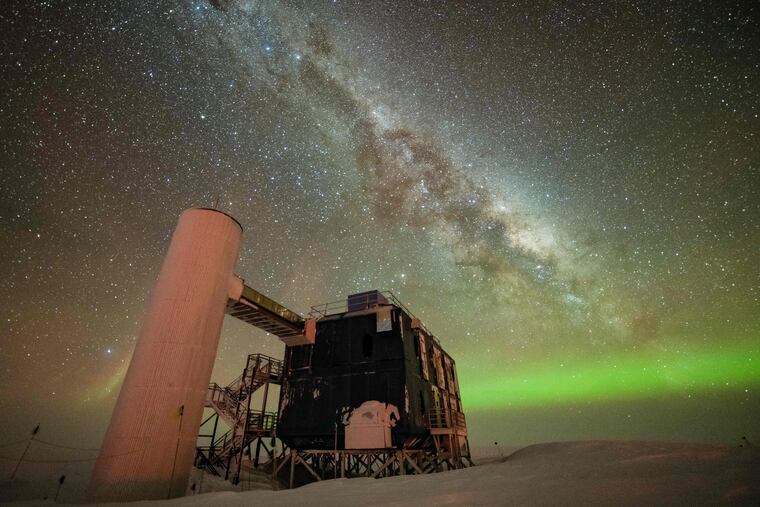South Pole observatory reveals hidden view of the Milky Way with help from Drexel physicists
The new view of our galaxy was created from cosmic particles called neutrinos. Penn State and University of Delaware researchers also were involved.

A team of more than 350 scientists said Thursday they had revealed a hidden view of the Milky Way, using an array of high-tech sensors buried in ice at the South Pole.
The novel image of our galaxy was generated not with visible light, but from cosmic “ghost particles” called neutrinos — a process that required sophisticated data analysis by key team members at Drexel University.
Physicists had predicted that these subatomic particles could originate from within the Milky Way, a vast, spinning disk of stars of which the Earth and our solar system are just a tiny part. But to confirm it, they needed Drexel’s machine learning algorithm to sift through millions of readings captured by the sensors over 10 years, said Naoko Kurahashi Neilson, a Drexel associate professor of physics.
The result is a view of the galaxy that can’t be seen with the naked eye.
“It’s like putting on a different set of glasses to look at the night sky,” she said.
The findings will help answer fundamental questions about high-energy physics, as neutrinos are created by violent, outer-space collisions that cannot be reproduced with experiments on Earth, said team member Steve Sclafani, a former Drexel graduate student now at the University of Maryland.
“We are seeing the Milky Way in neutrinos,” he said. “This is something that’s never been done before.”
The findings were published in the journal Science by scientists from more than 50 institutions, led by University of Wisconsin physicist Francis Halzen. The underground array of sensors used to detect the particles is called the IceCube Neutrino Observatory, built with funds from the National Science Foundation and sister agencies in more than a dozen countries.
Other area participants in the project included scientists from Pennsylvania State University and the University of Delaware. The latter helped build a component of the IceCube called IceTop.
An alien environment
While most of the Drexel team’s work was done on campus in West Philadelphia, Kurahashi Neilson and Sclafani also traveled to the South Pole observatory.
For the first leg of the journey, visitors fly to the Antarctic Coast. Then, because there are no runways at the South Pole, they switch to a special aircraft fitted with skis.
The environment is harsh and unforgiving, with temperatures typically reaching 35 degrees below zero. The research station is located at high altitude, 9,300 feet above sea level, so the air is thin and dry.
Kurahashi Neilson, who went to the pole in December 2011 (summertime down there), said that when she blew her nose, it would sometimes bleed.
“I’m not like this rugged explorer type,” she said. “I’m like the wimpiest person ever to go to this extreme environment.”
Sclafani went in 2019, carrying a Drexel flag for the occasion.
“It’s kind of an alien environment,” he said.
Machine learning
The South Pole faces the center of the Milky Way, making it a prime location for viewing the galaxy with the naked eye.
Doing it with neutrinos is much harder.
Sclafani used the machine learning algorithm to sift through millions of “events” detected by the IceCube sensors, most of them background noise. Working with Mirco Hünnefeld, a physicist at Technical University of Dortmund in Germany, Sclafani winnowed the list down to several hundred signals that actually came from neutrinos.
The readings allowed scientists to get a rough idea of where the particles came from in the galaxy, enabling them to construct a “picture” of the Milky Way through a new lens.
Kurahashi Neilson said she another Drexel researcher, postdoctoral fellow Michael Richman, proposed analyzing the data in this manner six years ago. But at first, other members of the 14-country consortium were skeptical that it would work.
No longer. Out of more than 350 scientists involved in the project, Kurahashi Neilson and Sclafani were among the few featured in the official news release announcing the discovery.
The key role of their data analysis was acknowledged by team member Denise Caldwell, director of the National Science Foundation’s Physics Division.
“The capabilities provided by the highly sensitive IceCube detector, coupled with new data analysis tools, have given us an entirely new view of our galaxy,” she said, “one that had only been hinted at before.”